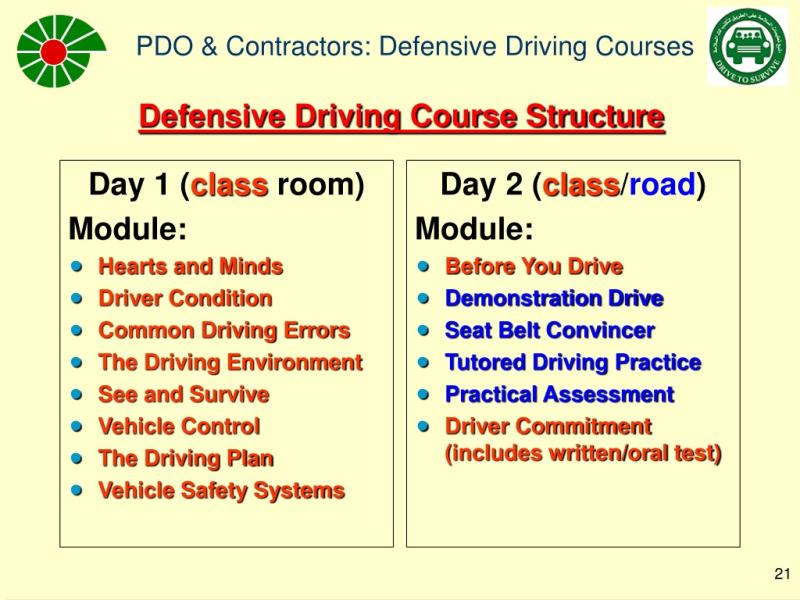What is defensive driving training?
Defensive driving training is a specialized form of driver education that goes beyond the basic mechanics of operating a vehicle. The primary focus of defensive driving is on teaching drivers proactive strategies to avoid accidents, anticipate potential hazards, and respond safely to challenging situations on the road. The goal is to develop a mindset that prioritizes safety and reduces the risk of collisions.
Key aspects of defensive driving training include:
Risk Awareness:
- Defensive driving emphasizes being aware of potential risks on the road, including the actions of other drivers, road conditions, and unexpected obstacles.
Anticipating Hazards:
- Drivers are taught to anticipate potential hazards and to recognize situations that may lead to accidents. This involves scanning the road ahead, checking mirrors regularly, and being alert to the actions of other drivers.
Maintaining a Safe Following Distance:
- Defensive driving encourages maintaining a safe following distance behind the vehicle in front. This provides more time to react if sudden braking or evasive maneuvers are necessary.
Speed Management:
- Controlling speed according to road conditions and posted speed limits is a crucial aspect of defensive driving. Adjusting speed in adverse weather, heavy traffic, or unfamiliar areas helps reduce the risk of accidents.
Proactive Decision-Making:
- Defensive drivers make decisions based on safety rather than convenience. This includes yielding the right of way, using turn signals, and making strategic lane changes.
Avoiding Distractions:
- Defensive driving emphasizes the dangers of distracted driving, such as using a cellphone, eating, or adjusting the radio while driving. Maintaining focus on the road is crucial for safe driving.
Managing Emotions:
- Defensive drivers are trained to manage their emotions and avoid aggressive or confrontational behavior on the road. Remaining calm and patient contributes to a safer driving environment.
Understanding Road Signs and Markings:
- Defensive driving courses cover the meaning of various road signs and markings, helping drivers navigate intersections, turns, and other traffic situations safely.
Emergency Maneuvers:
- Training may include techniques for handling emergency situations, such as skids, tire blowouts, or sudden obstacles in the road.
Legal and Ethical Considerations:
- Defensive driving training often includes information about traffic laws, legal responsibilities, and ethical considerations while driving.
Ongoing Education:
- Defensive driving is not a one-time event but a continuous process. Drivers are encouraged to stay informed about changes in traffic laws, safety technologies, and other relevant developments.
Defensive driving courses can be taken voluntarily by drivers looking to enhance their skills or as a requirement for traffic ticket dismissal or insurance discounts. Courses may be offered in-person or online, and they typically involve a combination of instructional material, multimedia content, and interactive elements. Successful completion of a defensive driving course may result in a certificate that can be presented to insurance providers or traffic courts.
Key Principles of Defensive Driving Training:
Defensive driving training focuses on teaching drivers proactive strategies to anticipate and avoid potential hazards on the road. The key principles include:
1. Hazard Recognition:
- Continuously scan the environment and identify potential hazards like other vehicles, pedestrians, cyclists, weather conditions, and road hazards.
- Anticipate potential risks and develop strategies to mitigate them.
2. Risk Assessment:
- Evaluate the severity and likelihood of potential hazards based on their distance, speed, and direction.
- Prioritize actions and adjust driving behavior accordingly.
3. Space Management:
- Maintain a safe following distance from the vehicle ahead based on speed and road conditions.
- Utilize proper lane positioning and avoid tailgating or erratic lane changes.
4. Decision-Making:
- Make informed decisions based on real-time assessment of the driving environment.
- Choose safe and responsible actions that minimize risks and avoid accidents.
5. Vehicle Control:
- Maintain proper control of your vehicle through smooth steering, braking, and acceleration techniques.
- Practice safe turning, merging, and stopping procedures.
6. Defensive Driving Techniques:
- Learn and implement specific techniques like maintaining awareness of blind spots, checking mirrors regularly, signaling clearly, and yielding appropriately.
- Develop skills for handling emergency situations like skids and hydroplaning.
7. Laws and Regulations:
- Thoroughly understand and comply with traffic laws and regulations.
- Stay informed about changes in traffic laws and safety regulations.
8. Attitude and Awareness:
- Develop a proactive and responsible attitude towards driving.
- Be aware of your limitations and avoid driving under the influence of fatigue, distractions, or substances.
Enhancing Road Safety Awareness:
Defensive driving training actively improves road safety awareness by:
- Developing a proactive mindset: Drivers are trained to anticipate and react to potential hazards, making them more alert and vigilant on the road.
- Improving hazard identification: Training teaches drivers to recognize and assess potential risks, allowing them to take early preventative measures.
- Promoting safe driving habits: By practicing defensive driving techniques, drivers develop safer habits that reduce risk-taking behaviors and improve overall driving performance.
- Encouraging responsible decision-making: Training helps drivers make informed decisions behind the wheel, considering potential consequences and prioritizing safe actions.
Practical Benefits of Defensive Driving:
Completing defensive driving courses offers numerous practical benefits, including:
- Reduced risk of accidents: Defensive driving techniques and awareness significantly lower the chances of accidents and collisions.
- Improved driving skills: Training enhances driving skills like vehicle control, anticipation, and risk assessment, making you a more confident and competent driver.
- Lower insurance premiums: Many insurance companies offer discounts for completing approved defensive driving courses.
- Reduced traffic violations: Defensive driving practices help avoid traffic violations and associated penalties.
- Increased confidence and peace of mind: Knowing you possess the knowledge and skills to navigate the road safely fosters confidence and reduces driving anxieties.
- Enhanced awareness of road safety: Defensive driving promotes a broader understanding of road safety principles, encouraging responsible driving behavior across the community.
Overall, defensive driving training provides valuable skills and knowledge that can significantly improve your driving experience and contribute to a safer road environment for everyone.









